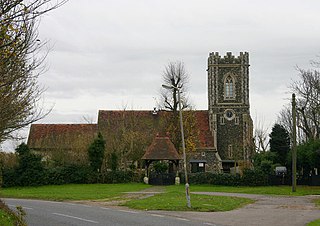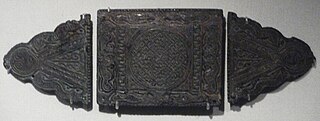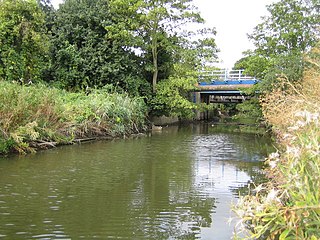
Thurrock is a unitary authority area with borough status in the ceremonial county of Essex, England. It lies on the north bank of the River Thames immediately east of London and has over 18 miles (29 km) of riverfront including the Port of Tilbury, the principal port for London. Thurrock is within the London commuter belt and is an area of regeneration within the Thames Gateway redevelopment zone. The borough includes the northern ends of the Dartford Crossing.

Grays is the largest town in the borough and unitary authority area of Thurrock, in the ceremonial county of Essex, England. The town, which is both a former civil parish and one of Thurrock's traditional Church of England parishes, is located on the north bank of the River Thames.
The title of oldest town in Britain is claimed by a number of settlements in Great Britain.

Bant's Carn is a Bronze Age entrance grave located on a steep slope on the island of St Mary's in the Isles of Scilly, England. The tomb is one of the best examples of a Scillonian entrance grave. Below Bant's Carn, lies the remains of the Iron Age village of Halangy Down.

Butser Ancient Farm is an archaeological open-air museum and experimental archaeology site located near Petersfield in Hampshire, southern England. Butser features experimental reconstructions of prehistoric, Romano-British and Anglo-Saxon buildings. Examples of Neolithic dwellings, Iron Age roundhouses, a Romano-British villa and an early Saxon house are on display. The site is used as both a tourist attraction and a site for the undertaking of experimental archaeology. In this latter capacity, it was designed so that archaeologists could learn more about the agricultural and domestic economy in Britain during the millennium that lasted from circa 400 BCE to 400 CE, in what was the Late British Iron Age and Romano-British periods.

Barstable was a Hundred in the English County of Essex. Both the hundred and the manor with the same name are mentioned in the Domesday Book of 1086. A number of parishes in the western part of the Barstable hundred are now in Thurrock.
Piddington Roman Villa is the remains of a large Roman villa at Piddington, Northamptonshire, about 6 miles (9.7 km) south-east of Northampton, a county in the East Midlands of England.

Chadwell St Mary is an area of the unitary authority of Thurrock in Essex, England. It is one of the traditional parishes in Thurrock and a former civil parish. Grays is 2 miles (3.2 km) to the west and 1 mile (1.6 km) to the south is Tilbury. The area is sometimes referred to simply as Chadwell, particularly before the 19th century.

Thurrock was a local government district and civil parish in south Essex, England from 1936 to 1974.

West Tilbury is a village and former civil parish in the Thurrock district, in the ceremonial county of Essex, England. It is on the top of and on the sides of a 30 metres (98 ft) tall river terrace overlooking the River Thames. Part of the modern town of Tilbury is within the traditional parish of West Tilbury. In 1931 the parish had a population of 444. On 1 April 1936 the parish was abolished to form Thurrock.
Orsett Rural District was a local government district centred on Orsett in the south Essex part of the Thames Estuary in England. It was a rural district from 1894 to 1936, initially made up of seventeen civil parishes and the successor to the Orsett Rural Sanitary District. Parts of the district were split off to form Tilbury in 1912, Purfleet in 1929 and Billericay in 1934. Thurrock Urban District was the main successor district in 1936. Today it corresponds to the Thurrock unitary authority area with parts in Basildon, Essex and Havering, Greater London.

Mucking is a hamlet and former Church of England parish and civil parish adjoining the Thames Estuary in the Thurrock unitary authority area, in southern Essex, England. It is located approximately 2 miles (3.2 km) south of the town of Stanford-le-Hope. In 1931 the civil parish had a population of 498.

East Tilbury is a village and former civil parish in the unitary authority of Thurrock borough, Essex, England, and one of the traditional Church of England parishes in Thurrock. In 2011 the ward had a population of 6,363.

Mucking is an archaeological site near the village of Mucking in southern Essex. The site contains remains dating from the Neolithic to the Middle Ages—a period of some 3,000 years—and the Bronze Age and Anglo-Saxon features are particularly notable.
Terrel's Heath is, in spite of its name, an area of woodland in Chadwell St Mary named on the 1938 six-inch Ordnance Survey map.

Orsett Heath is a location and recently built hamlet in the unitary authority area of Thurrock, in the ceremonial county of Essex, England. It is located about twenty miles away from London. Nearby settlements include the towns of Tilbury and Grays and the villages of Orsett and Chadwell St Mary. For transport there is the A13 road, the A1089 road and the A1013 road nearby. The nearest railway station is Tilbury Town.

The Mardyke is a small river, mainly in Thurrock, that flows into the River Thames at Purfleet, close to the Queen Elizabeth II Bridge. In part, it forms the boundary between the Essex hundreds of Barstable and Chafford. The river gives its name to the Mardyke Valley—a project aimed at increasing appreciation and usage of recreational land around the Mardyke.
The archaeology of Anglo-Saxon England is the study of the archaeology of England from the 5th century AD to the 11th century, when it was ruled by Germanic tribes known collectively as the Anglo-Saxons.

West Stow Anglo-Saxon Village is an archaeological site and an open-air museum located near to West Stow in Suffolk, eastern England. Evidence for intermittent human habitation at the site stretches from the Mesolithic through the Neolithic, Bronze Age, Iron Age and Romano-British period, but it is best known for the small village that existed on the site between the mid-5th century and the early 7th century CE, during the early Anglo-Saxon period. During this time, around 70 sunken-featured buildings were constructed on the site, along with 8 halls and a number of other features. Subsequently, abandoned, the area became farmland in the Late Medieval period.

Margaret Ursula Jones was an English archaeologist, best known for directing major excavations at Mucking, Essex.